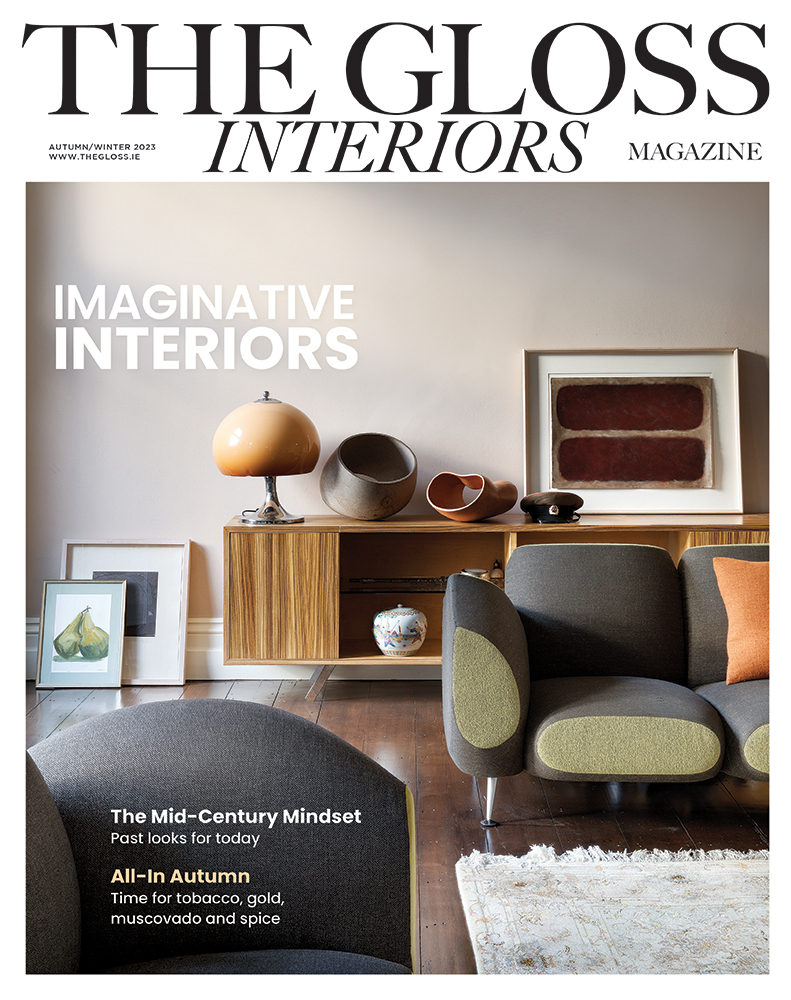As much an expression of who we are as the clothes we wear, our homes anchor us, shelter us and soothe us, says MARY O’DONNELL, especially when a storm (real or figurative) rages outside the door …
I’m not someone who automatically loved the two homes in which I’ve lived as an adult. Neither was what I’d have chosen initially, but I put down roots and am expert at turning things which don’t quite work into something that does. I remember when leaving our first home after eight years, lifting a piece of loose wallpaper and writing in black marker the words We Were Happy Here. I wanted to pass something on to the next couple, who would make their own changes, just as we had done, but to tell them that yes, you can be happy in this place. And when leaving my late aunt’s home for the last time, having emptied it and sold her music-filled house to a young woman, I scrawled a message on the bedroom wall, letting her know that A Good Woman Lived Here.
With all our clutter, most of us secretly harbour the idea of a domestic idyll. Often rooted in our own vernacular past, homes carry a secret dream ferried down all the preceding generations that have lived beneath roofs and within walls. Your own home might be a mess, an untidy conglomeration of mixed styles, crooked pictures, and faded photographs. It might be quite old-fashioned, or too poky, with pieces of furniture bought decades ago, which the dog sleeps on while the cat occupies the top of that old Italian drinks cabinet, a souvenir of a happy splurge in the 1990s. In other homes, the dream is actualised in a more contemporary way, with lines that draw the eye to this or that coveted object: a small piece of sculpture on a plinth, a Morandi-like jug, a kitchen counter with softly gleaming brass taps, and an Inglenook fireplace with inset stove in which wood burns and glows through the cold spring days. The thing is though, we are enclosed, womb-like, each in our own space, and here we retreat, childlike, regardless of how the day has gone.
The idea of the “domestic” took a bashing during the 1970s and 1980s, when many people stampeded away from anything that smacked of conformity and apparent mediocrity. In the UK, films and novels set in the industrial North became a reflection of what young people wanted to avoid. The domestic, unless one had lots of dosh, guaranteed the crippling of dreams and the stifling of love as witnessed in gritty dramas from John Osborne, Sheelagh Delaney and the like. Love in a cramped one-room flat, or being pregnant and in that one-room flat, were recipes for disaster.
In Ireland the pattern of marriage, children, plus suburban home also came to be fashionably derided as a template for the erasing of originality. Today, city people in particular are fussy about location no matter what the house, with some poor darlings maxing out on Mum and Dad’s generosity to secure that must-have D2, 4, 6 or 8 property, and whether you’re talking about Clontarf or Portobello, Blackrock or Baldoyle, Montenotte or Shandon, everyone carries a truckload of assumptions about the lives led by others.
The groundwork for this snobbishness was laid by trendy commentators who once found in the suburbs the stuff of creative rebellion. Rebellion against what? Against poverty and limited means, for sure, but also against everything that was bourgeois and therefore very boring. Think of Luis Bunuel’s 1972 movie The Discrete Charm of the Bourgeoisie which brilliantly critiques that little entertainment so beloved of the well-off middle-classes: the dinner-party. And although we continue to cast ourselves as main actors in such scenarios, the ideal of living unjudged is now a respected one, with the suburbs no longer viewed as a kind of horse’s graveyard for smug and ambitionless one-size-fits-all losers.
Consciousness of patterning, colour, and shape, have ushered in a new world, arguably inspired by the Dutch master painters. Floor tiles, mirrors, wall patternings – now where have we seen those before? In Hans Holbein the Younger? Or Vermeer? Well, check out the black-and-white tiled floors of our older housing stock, the red-and-black tiled kitchens, the heavy wooden tables and wicker baskets of home-made loaves, check out the brick-surrounded fireplaces, the copper coal scuttle and again there’s a strong echo of Vermeer and his ilk.
Your own home might be a mess, an UNTIDY CONGLOMERATION of mixed styles, crooked pictures, and faded photographs. It might be quite old-fashioned, or too poky, with pieces of furniture bought decades ago …
Because such artists observed the life of the home as a site in which important things happened. Letters are read in secret, a girl absent-mindedly pours milk from a heavy earthenware jug, accounting is done in the kitchen while some background figure throws logs on the fire, and sometimes, the best of craic is to be had at heavy tables, where men smoke their heads off, laughing and joking as they drink frothing beers.
That domestic world, like ours, is a receptacle for secrets, for fidelity and infidelity, for peaceful ways and violent ways, for gatherings with family and friends, that reflect the tides of our restless hearts. Because it’s within home life that every emotion washes in and over us, where love is found and sometimes lost. In bedrooms the length and breadth of the country an attempt has been made to shape this space in which, nightly, we lay our tired bodies, arranging our limbs for sleep, or perhaps where we anxiously lie awake fretting at 3am, later welcoming the frill of light beneath morning curtains. The pictures we select, the coverings on the bed, the bed itself, are sacred vessels in a habitually enacted ritual.
My own bedroom is full of beautiful nude art, because surely this is the most interior of spaces for the human body. I love my old Ingres print called Grande Odalisque in which the artist gave the model a ridiculously extended neck and a misaligned hip, I love her because she is not what we call “normal” in shape; and I love the young girl in a lake on a misty morning by some French artist whose name I forget, because this was the first ever print I bought, when I too was a little like that young girl: nervous, sensuous, in search of something I hardly recognised in myself.
My love of the domestic interior comes directly from my mother. I told her recently what a great home she made for us, because it was never just a country house so much as a place which she invigorated with her love of colour, texture and remarkable objects. It was she who purchased a large library of miscellaneous books at an auction at one of the big homes of the era, to satisfy my father’s love of books. It was she who shaped the old house, who made it a comforting place to which I always wanted to return.
The thing about a domestic environment – when it works – is that people want to be there. I have known people who, as soon as they left school, rarely returned to their first home, where books had been burned by tyrant parents, and ugly rooms were full of complaining voices, where the young life in them was so stifled that they vowed never again to spend much time beneath that roof. But people with happier experiences want to hear that ticking clock on the landing, like a heartbeat in the middle of the night, to feel comforted by its steadiness when life itself may be very unstable, when a storm rages outside the door. They want to sit at that kitchen table and eat together in a place where some happy cook has made an honest, hearty meal, inspired by travel or reading or mere appetite. They want to tease out extreme ideas, to laugh and be uninhibited and free of the facile judgements of the Twittersphere and Facebook.
Some people are profoundly satisfied by living in clean, very tidy homes. That is their pleasure. Others are buoyant within an untidy colour-filled riot of this and that, with disordered pots and pans and hints of many lives lived elsewhere. That is their pleasure. Either way, it’s all fine. Because this is the best and only space in which we can truly be, as much an expression of ourselves as the clothes we wear. Think of a mirror. A still lake. A reflection. Because a home, an interior, walls and a roof are all of these and more, a reflection of your mysterious soul-self. Rejoice.
Image credit: “Room in a Dutch House” by Pieter Janssens Elinga
LOVETHEGLOSS.IE?
Sign up to our MAILING LIST now for a roundup of the latest fashion, beauty, interiors and entertaining news from THE GLOSS MAGAZINE’s daily dispatches.









